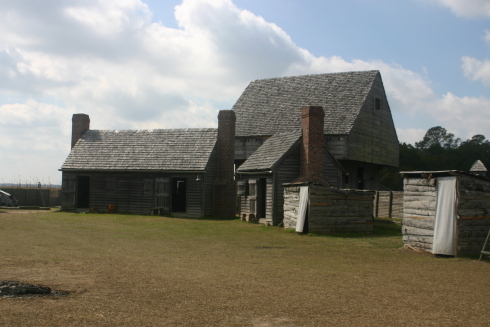DARIEN, Ga. – South Georgia in the 1720s and 1730s wasn’t a pleasant place to be. The men who settled Fort King George along the Altamaha River near what is modern day Darien learned that during the fort’s rather short existence.
Built in 1721 – 12 years before “Georgia’s First City,” Savannah, was founded – Fort King George was both the first English settlement on Georgia’s coast and the British Empire’s southernmost outpost in North America. It remained the southernmost settlement until 1736 when Fort Frederica was built on what is today St. Simon’s Island.
Col. John “Tuscarora Jack” Barnwell, a South Carolina resident pushed for the fort. Hoping for a competent group of soldiers to help him construct the fort, he was instead provided with a collection of invalid soldiers – known as His Majesty’s Independent Company of South Carolina. Perhaps foreshadowing the hard times that lay ahead, Barnwell’s crew became sick with scurvy while en route from London to Charleston, S.C., where they were headed before Georgia.
As the majority of his men recovered, Barnwell and a smaller group of scouts continued onward to start construction on a piece of land amid a swath of natural marshland. Avoiding a near mutiny, the men were able to construct the fort, including a three-story cypress blockhouse, which provided space to store ammunition and a top-floor lookout. Unfortunately for the settlers, the marshes meant the surrounding area remained damp. The marshes also led to flooding of the fort.
The fort’s purpose was to stem French and Spanish advances into English territory even though it was built in Spanish territory, although South Carolina claimed the land from here to near St. Augustine. The fort’s residents lived through disease, threats of attacks from both the Spanish and Indian, and an unfamiliar coastal environment – salt meat rotted in this environment and fruits were not a part of the everyday diet.
A fire destroyed the fort in winter 1725; the structure was rebuilt, though to a lesser quality, which only heightened the suffering of those living at the fort. During those six years, more than 140 of the fort’s inhabitants died and were buried on a nearby bluff. None of the deaths came in battle.
The fort was eventually abandoned in 1727, although South Carolina rangers stayed behind until March 1734 – about three months before Georgia was founded as a colony. In 1736, Gen. James Oglethorpe brought Scottish Highlanders to the area, founding the city of Darien. Over time, the location of the fort was lost until it was rediscovered in 1932.
Until the 1920s, Darien became an important lumber center, hence its nickname, “Lumber City.” In fact, a sawmill was later built on the site, which likely destroyed any remains of the original fort. However, the sawmill’s remains offer a rare glimpse into Georgia’s early colonial industry.
With the help of historic drawings, the Lower Altamaha Historical Society and the Georgia Department of Natural Resources in 1988, a number of the fort’s structures were rebuilt, including the cypress blockhouse. The reconstructed fort is a replica of Barnwell’s original construction.
Today, the park highlights the area’s 18th century cultural history, including the Guale Indians, the 17th century Spanish mission Santo Domingo de Talaje, Fort King George and the Scottish colonists. In addition, the state park features information about 19th century sawmilling.
For more information, log onto http://www.gastateparks.org/info/ftkinggeorge/.






1 Trackback / Pingback
Comments are closed.